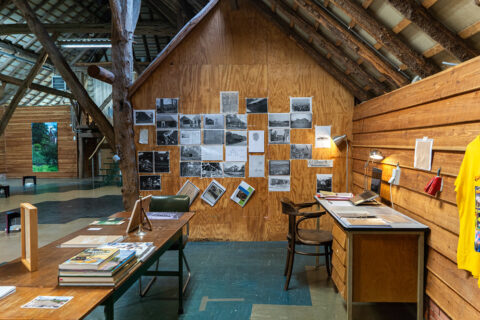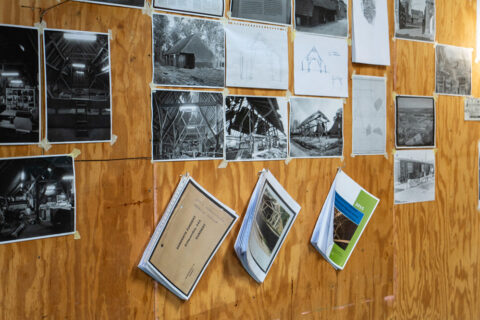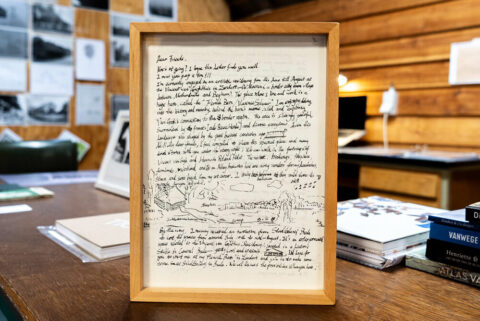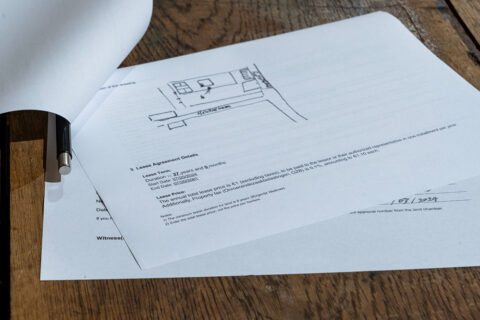30 July 2024
Interview
From Barn to Stable, Angus

This Tuesday might be the hottest day of the year, at least in the Netherlands, it is 31 degrees Celsius and no clouds to be seen. On my way to artist Zhixin Angus Liao in De Moeren near Zundert, to visit him at the end of his two-month residency hosted by AIR van Gogh, the sun is burning, but in the old Flemish shed it is cool. Even during summer Angus had some cold days and needed to use the stove sometimes to get the cold out.
From farm to stable
Angus is sitting in the front of the barn, the door open, together with one of his visiting artists friends. ‘Please take a seat’ while he offers some refreshments. He first arrived here in June, and after July he will be leaving ‘tomorrow actually’ but will be still around because he is preparing a presentation in the Artspace StadsGalerij Breda that will open at the 10th of August.
‘I was working here researching some more about the concept ‘farm to table’ and paraphrase this in the title of the show: Barn to Stable. As you know we are now sitting in a barn. It is called a Flemish barn, which is not true because it received this name around the 60’s or 70’s of the last century. Actually, the barn is not erected here, there was another barn here before that was moved across the street, and later this one came here. It was built in 1665, and the inner construct is still from that time, but the outside is built much later. Originally this barn, while standing somewhere else, was used for collecting royal taxes. Not money, but a part of the harvest of the land that were gathered here for the master’s that governed the area. I connected that to the stable in Breda, now called StadsGalerij, because that was part of the military system operational there in the 19th century, also part of the government. Another connection is the ‘turf’ the material used for cooking and heating in those days, it came from here. There was a canal to bring this to the city of Breda. Really funny to discover that the land was actually 3 meters higher, because of all the ‘turf’ they took from here the earth level changed. Living here is forgetting the time, mostly I research the City-archive in Breda and the archive of West-Brabant, where this place belongs to. And the archive of the owner who lives just across the street, the whole network of knowledge comes from here.‘

Photo by Zhixin Angus Liao
About the Dutch border
The estate De Moeren, is just outside Zundert. For many people is Zundert just a local village, but compared to the environment that we are now it is almost city life, and here it is without a doubt the countryside. While sitting here, drinking tea and eating watermelon, people pass by walking and waving or cycling and greeting. ‘This is one of my best residencies so far’ Angus stated, ‘it’s not about the institute but for the local people and their culture, which is so open’. Angus also told that he studied in Groningen but that was so different there. The difference between the north and the south, between protestant and catholic, and the border…
‘My main research is about the Dutch border – I like it very much to be here so close to the border – the perfect place to focus on the Dutch Belgium confrontation. There is something about it, being one country and then split up in two. I lived in various cities in the Netherlands and Belgium, and now temporarily based in Brussels. I sense the history, but also, I see the difference. Belgium is sort of ‘chaotic’ while the Netherlands is very solid, it is like a brick. I always see the artistic migration as a cumulation of good behaviour, like if you want to migrate to the Netherlands, then you need to be a company, have a KvK number and prove that you are an artist, that your work matters, that you are successful by getting invitations to show your work, earn money with it and prove this with letters of support. And then you can live here. So, the bureaucracy is perfect here. It is really very clear, no grey lines. You just need to find the right person. That makes artistic migration so interesting; by learning you know how to pass your exam’.

Photo by Zhixin Angus Liao

Photo by Zhixin Angus Liao
Local guide
During the residency Angus became aware that while researching the barn and the border, he actually did not need all the space, and the barn provides al lot of square meters; so, he invited his artist friends by sending a real physical and handwritten letter: ‘I use this letter as a sort of stamp, an invitation to create’. About 20 of his friends reacted, and about 14 came. Although it is not easy to come here, no public transport will stop at the doorstep, so everybody has to organize their own transport and if no one owns a car, they have to be creative with sharing bikes and planning the route.
‘I invited international artists who are based in the Netherlands or Belgium to come here and take a break from the system. So, everybody that is tired of the efforts for the application for migration was welcome to work, or just visit. And they came in a row, of course mainly the last week. And now Muxingye Chen is here, who is the last friend to visit me. Everybody always seem to be able to see something new in these surroundings. At first, I was here the local guide for my guests because a lot of my neighbours here are fantastic, they showed me around, showed their houses, and told me a lot of stories. And stories are about exchange. Also, my friends did, because every time they saw something I did not notice before like for example an artist friend that researched French hunting grounds, she was convinced that she saw the remains of that here, but I read in the archive that everything here is more British style until we found out that this particular family had strong French connections, so she was right after all.
Not everybody made new work, that was not necessary, but I am happy if they did and be able to show it. Not here, but in the StadsGalerij in Breda where I have the opportunity to show their works, and some of my work.’
Open studio
In the last weekend of his residency, 24th of July, Angus held an open studio. Almost all the people from the neighbourhood came to talk some more, share stories and see what his research to this old barn has brought so far. To his surprise one of the first visitors was someone he did not met before, it was the old forester that was responsible for rebuilding the barn.
‘He came back later to explain some more about the barn. My ideas for making work all came from the influence that the open studio had. Knowing that the barn is moveable, it is a simple construction that easily could be rebuild, resonated in the back of my mind. I focused on the essential part of the structure that is called in Dutch ‘slof’ and is a stone between the foundation made by brickwork and the wood that carries the roof. This ‘slof’ is the only part that people can change if the wood is shrinking so it is a very essential element. I made some works based on this stone and the foundation. I had no materials, no tools and there is no facility whatsoever here, so I needed all the help I could get. And luckily, there was also a network of helping people here. For example, I never cut into stone, but here I learned that and shut myself up in a workshop for several days to make this ‘slof’ again as part of my sculptures.
But there is more, I made a deal with his temporarily neighbours, or actually the owners of this surrounding land the family Van der Hoeven. I made a specific ‘slof ‘ with the same measurement of 40×40 cm and engraved with KvK number. The deal took form in a signed agreement in which I rent the same size of land on their property for exactly 37 years, and pay each year the amount of € 1,- as rent. My work is always conceptual and attracted to the concept of property and ownership. So, this is perfect here; I prove my loyalty to the Dutch government. As a foreigner, there are so many borders to come across. You have to show everything to the system like who you are, what you do. I follow their steps as a good migrant.

Photo by Zhixin Angus Liao
